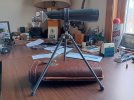Snakeoil
Well-Known Member
About 30 years ago, I bought this cute little 20X40 spotting scope at a gun shop. It was in a box with a bunch of misc cast-offs like S&W wood grips. Anything in the box was $5. Scope came in a hard leather case with a tripod. It initially went to our camp in case I decided to go shooting and needed a spotting scope. Soon, it was clear that it was better to just put it in my car and leave it there. Since then it has come in handy more than a few times when a spotting scope was needed, but none were available.
The scope is made in Japan and has the name Observer on it. I did some searches on the web earlier today and could not find any info on it. But I did find a few photos of very similar scopes, several of which were named Selsi. There were some other brands and my guess is these were all made in the same post-WWII factory and branded accordingly based upon who placed an order. My guess is this scope was made sometime in the early 60's.
The lenses are all glass. It is a prismatic scope and the optics are superb. It never fails to impress members at the club when they see this dinky little scope on the bench and chuckle until I tell them to take a look thru it. Wow is the usual response.
The ocular lens is twisted to bring the scope into focus and I'm sure that it still had the original grease with which it left the factory. I had it out to spot for some guys at the club on Wed and it had been so cold that it was almost impossible to turn the lens to focus. So, today, I pulled the ocular lens assembly off the scope to remove the old lube and put it new. I actually had to drizzle a little acetone down into the threads because I could not hold it right enough in my fingers to unscrew the components. It took some doing to remove that former grease, now taffy, from the threads. To my surprise, the focal threads are tiny acme threads. This scope is truly well made. And it was made right around the time when products from Japan were no longer considered cheap junk.
With new grease, the ocular moves nicely. So, back in the case and back into the car for the next time it's called into duty.
Here is a pic of the scope, tripod and case. The scope itself measures a whopping 8-1/8" from end to end.

The scope is made in Japan and has the name Observer on it. I did some searches on the web earlier today and could not find any info on it. But I did find a few photos of very similar scopes, several of which were named Selsi. There were some other brands and my guess is these were all made in the same post-WWII factory and branded accordingly based upon who placed an order. My guess is this scope was made sometime in the early 60's.
The lenses are all glass. It is a prismatic scope and the optics are superb. It never fails to impress members at the club when they see this dinky little scope on the bench and chuckle until I tell them to take a look thru it. Wow is the usual response.
The ocular lens is twisted to bring the scope into focus and I'm sure that it still had the original grease with which it left the factory. I had it out to spot for some guys at the club on Wed and it had been so cold that it was almost impossible to turn the lens to focus. So, today, I pulled the ocular lens assembly off the scope to remove the old lube and put it new. I actually had to drizzle a little acetone down into the threads because I could not hold it right enough in my fingers to unscrew the components. It took some doing to remove that former grease, now taffy, from the threads. To my surprise, the focal threads are tiny acme threads. This scope is truly well made. And it was made right around the time when products from Japan were no longer considered cheap junk.
With new grease, the ocular moves nicely. So, back in the case and back into the car for the next time it's called into duty.
Here is a pic of the scope, tripod and case. The scope itself measures a whopping 8-1/8" from end to end.


